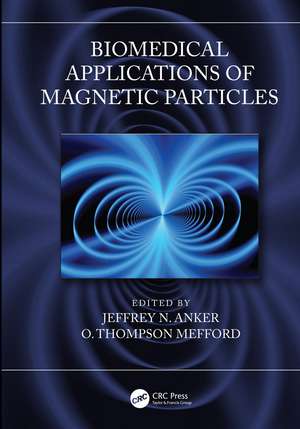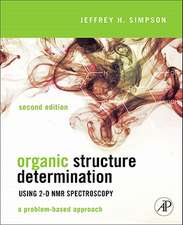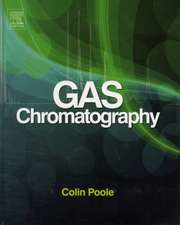Biomedical Applications of Magnetic Particles
Editat de Jeffrey N. Anker, O. Thompson Mefforden Limba Engleză Hardback – 17 dec 2020
The first section presents the fundamentals of the field by explaining the theory of magnetism, describing techniques to synthesize magnetic particles, detailing methods to characterize magnetic particles, and quantitatively describing the applied magnetic forces, torques, and the resultant particle motions. The second section describes the wide range of biomedical applications, including chemical sensors, cellular actuators, drug delivery, magnetic hyperthermia, magnetic resonance imaging contrast enhancement, and toxicity.
Additional key features include:
- Covers both introduction to physics and characterization of magnetic nanoparticles and the state of the art in biomedical applications
- Authoritative reference for scientists and engineers for all new or old to the field
- Describes how the size of magnetic nanoparticles affects their magnetic properties, colloidal properties, and biological properties.
| Toate formatele și edițiile | Preț | Express |
|---|---|---|
| Paperback (1) | 462.39 lei 6-8 săpt. | |
| CRC Press – aug 2022 | 462.39 lei 6-8 săpt. | |
| Hardback (1) | 1105.17 lei 6-8 săpt. | |
| CRC Press – 17 dec 2020 | 1105.17 lei 6-8 săpt. |
Preț: 1105.17 lei
Preț vechi: 1285.07 lei
-14% Nou
Puncte Express: 1658
Preț estimativ în valută:
211.47€ • 221.39$ • 174.98£
211.47€ • 221.39$ • 174.98£
Carte tipărită la comandă
Livrare economică 05-19 aprilie
Preluare comenzi: 021 569.72.76
Specificații
ISBN-13: 9781439839683
ISBN-10: 1439839689
Pagini: 370
Ilustrații: 100 b/w images
Dimensiuni: 178 x 254 mm
Greutate: 0.84 kg
Ediția:1
Editura: CRC Press
Colecția CRC Press
ISBN-10: 1439839689
Pagini: 370
Ilustrații: 100 b/w images
Dimensiuni: 178 x 254 mm
Greutate: 0.84 kg
Ediția:1
Editura: CRC Press
Colecția CRC Press
Public țintă
Biomedical engineers, biophysicists, analytical chemists, materials scientists, biologists who use magnetic particle separations and magnetic transfection techniques, and radiologists who use MRI contrast agents.Cuprins
Table of Contents
Foreword..........................................................................................................................................vii
Preface...............................................................................................................................................ix
Editor Bios........................................................................................................................................xi
List of Contributors ........................................................................................................................xiii
Chapter 1 Introduction to Biomedical Applications of Magnetic Nanoparticles.......................1
SECTION I Magnetic Particle Fundamentals
Chapter 2 A Conceptual Introduction to the Fundamentals of Magnetic Fields,
Magnetic Materials, and Magnetic Particles
for Biomedical Applications.......................................................................................7
Chapter 3 Magnetic Forces and Torques: Separation, Tweezing, and Materials
Assembly in Biology ................................................................................................33
Chapter 4 Colloidal Interactions of Magnetic Nanoparticles ...................................................59
Chapter 5 Magnetic Characterization: Instruments and Methods ............................................83
SECTION II Magnetic Particle Applications
Chapter 6 Synthesis and Functionalization of Magnetic Particles .........................................121
Chapter 7 Nanomagnetic Actuation: Controlling Cell Behavior with Magnetic
Nanoparticles...........................................................................................................159
Chapter 8 Magnetic Nanoparticles: Challenges and Opportunities in Drug Delivery ..........177
Chapter 9 Magnetic Particle Biosensors .................................................................................197
Chapter 10 Magnetic Contrast Imaging: Magnetic Nanoparticles as Probes in
Living Systems .......................................................................................................241
Chapter 11 Energy Dissipation by Magnetic Nanoparticles: Basic Principles
for Biomedical Applications ..................................................................................275
Chapter 12 Toxicology of Magnetic Nanoparticles .................................................................305
Index..............................................................................................................................................345
Foreword..........................................................................................................................................vii
Preface...............................................................................................................................................ix
Editor Bios........................................................................................................................................xi
List of Contributors ........................................................................................................................xiii
Chapter 1 Introduction to Biomedical Applications of Magnetic Nanoparticles.......................1
SECTION I Magnetic Particle Fundamentals
Chapter 2 A Conceptual Introduction to the Fundamentals of Magnetic Fields,
Magnetic Materials, and Magnetic Particles
for Biomedical Applications.......................................................................................7
Chapter 3 Magnetic Forces and Torques: Separation, Tweezing, and Materials
Assembly in Biology ................................................................................................33
Chapter 4 Colloidal Interactions of Magnetic Nanoparticles ...................................................59
Chapter 5 Magnetic Characterization: Instruments and Methods ............................................83
SECTION II Magnetic Particle Applications
Chapter 6 Synthesis and Functionalization of Magnetic Particles .........................................121
Chapter 7 Nanomagnetic Actuation: Controlling Cell Behavior with Magnetic
Nanoparticles...........................................................................................................159
Chapter 8 Magnetic Nanoparticles: Challenges and Opportunities in Drug Delivery ..........177
Chapter 9 Magnetic Particle Biosensors .................................................................................197
Chapter 10 Magnetic Contrast Imaging: Magnetic Nanoparticles as Probes in
Living Systems .......................................................................................................241
Chapter 11 Energy Dissipation by Magnetic Nanoparticles: Basic Principles
for Biomedical Applications ..................................................................................275
Chapter 12 Toxicology of Magnetic Nanoparticles .................................................................305
Index..............................................................................................................................................345
Notă biografică
Jeffrey N. Anker is a Wallace R. Roy Distinguished Professor of Chemistry
and BioEngineering at Clemson University. He earned his BS degree in
applied physics at Yale University in 1998. He earned his doctorate at The
University of Michigan in 2005, working for Professor Raoul Kopelman
to develop magnetically modulated optical nanoprobes (MagMOONs) to
measure chemical concentrations and mechanical properties of solutions. For
this work, he was awarded a grand prize at the 2002 National Inventor’s
Hall of Fame Collegiate Inventor’s Competition. From 2005 to 2008,
Dr. Anker worked as an NIH National Science Research Award (NSRA)
postdoctoral research fellow at Northwestern University under the guidance of Professor
Richard Van Duyne. His postdoctoral research focused on developing real-time high-resolution
plasmonic nanosensors. He joined the Clemson Chemistry Department in August 2008. Current
research focuses on imaging and spectroscopy using magnetic, plasmonic, x-ray excited microand
nanosensors, implantable sensors, orthopedic devices, and medical imaging. Along with
Thompson Mefford, he founded the Frontiers in BioMagnetic Particles Meeting Series. Awards
include: NSF CAREER award (2013); Clemson Faculty Collaboration Award (2014); Clemson
University School of Health Research (CUSHR), and Greenville Health System Embedded
Faculty Fellow (2018); University Research, Scholarship, and Artistic Achievement Award
(USRAAA) (2018); and senior member of the National Academy of Inventors (2019).
O. Thompson Mefford is an Associate Professor in the Department of
Materials Science Engineering where he holds a David and Mary Ann Bishop
Dean’s Professorship, along with an additional appointment in the Department
of Bioengineering at Clemson University. He earned his BS degree
in Polymer and Textile Chemistry at Clemson in 2003 and a PhD in
Macromolecular Science and Engineering from Virginia Tech in 2007,
where he worked on the development of treatments for retinal detachment
using hydrophobic ferrofluids. Before returning back to Clemson, Dr. Mefford
developed methods for the fabrication and functionalization of microfluidic
devices as a Post-doctoral Researcher for The Ohio State University Department of Chemistry.
Dr. Mefford joined the faculty of the Department of Materials Science and Engineering at Clemson in
the Fall of 2008. His research focuses on developing stable, polymer-iron oxide nanoparticle
complexes and composites for biomedical applications. These applications include developing
materials for magnetically modulated energy delivery, MRI contrast agents, and drug delivery
systems. He currently organizes the Frontiers in Magnetic Particles Conference (www.
magneticnanoparticle.com). In his free time, Dr. Mefford is found running, cycling, sailing,
backpacking, and home brewing.
and BioEngineering at Clemson University. He earned his BS degree in
applied physics at Yale University in 1998. He earned his doctorate at The
University of Michigan in 2005, working for Professor Raoul Kopelman
to develop magnetically modulated optical nanoprobes (MagMOONs) to
measure chemical concentrations and mechanical properties of solutions. For
this work, he was awarded a grand prize at the 2002 National Inventor’s
Hall of Fame Collegiate Inventor’s Competition. From 2005 to 2008,
Dr. Anker worked as an NIH National Science Research Award (NSRA)
postdoctoral research fellow at Northwestern University under the guidance of Professor
Richard Van Duyne. His postdoctoral research focused on developing real-time high-resolution
plasmonic nanosensors. He joined the Clemson Chemistry Department in August 2008. Current
research focuses on imaging and spectroscopy using magnetic, plasmonic, x-ray excited microand
nanosensors, implantable sensors, orthopedic devices, and medical imaging. Along with
Thompson Mefford, he founded the Frontiers in BioMagnetic Particles Meeting Series. Awards
include: NSF CAREER award (2013); Clemson Faculty Collaboration Award (2014); Clemson
University School of Health Research (CUSHR), and Greenville Health System Embedded
Faculty Fellow (2018); University Research, Scholarship, and Artistic Achievement Award
(USRAAA) (2018); and senior member of the National Academy of Inventors (2019).
O. Thompson Mefford is an Associate Professor in the Department of
Materials Science Engineering where he holds a David and Mary Ann Bishop
Dean’s Professorship, along with an additional appointment in the Department
of Bioengineering at Clemson University. He earned his BS degree
in Polymer and Textile Chemistry at Clemson in 2003 and a PhD in
Macromolecular Science and Engineering from Virginia Tech in 2007,
where he worked on the development of treatments for retinal detachment
using hydrophobic ferrofluids. Before returning back to Clemson, Dr. Mefford
developed methods for the fabrication and functionalization of microfluidic
devices as a Post-doctoral Researcher for The Ohio State University Department of Chemistry.
Dr. Mefford joined the faculty of the Department of Materials Science and Engineering at Clemson in
the Fall of 2008. His research focuses on developing stable, polymer-iron oxide nanoparticle
complexes and composites for biomedical applications. These applications include developing
materials for magnetically modulated energy delivery, MRI contrast agents, and drug delivery
systems. He currently organizes the Frontiers in Magnetic Particles Conference (www.
magneticnanoparticle.com). In his free time, Dr. Mefford is found running, cycling, sailing,
backpacking, and home brewing.
Recenzii
"When I opened this book and saw the list of authors I instantly knew that it was going to become the first book I’d recommend to every person starting to work in this field.
The experience Thompson Mefford and Jeffrey Anker have organizing the Frontiers in Magnetic Nanoparticles Conference series is clearly reflected in this book. They have made the perfect selection of leading experts to describe all of the most recent advances in each biomedical application, but at the same time have made an impressive effort to compile the state of the art in characterization techniques used to understand the fundamental properties of the magnetic nanoparticles.
Altogether, this makes the book both accessible to newcomers to the field of magnetic nanoparticles as well as highly recommended for professionals who are aiming for deeper fundamental insights."
- Lucía Gutiérrez, Research Fellow, University of Zaragoza
"Biomedical Applications of Magnetic Particles marks a moment in time when seemingly impossible connections are being made, at the nanoscale, between inorganic matter and organic forms - from proteins to tissues - for the benefit of the health of us all. It is an exemplary combination of explanation and inspiration. It’s first third comprises a review of the underpinning science, written in an easily understood style. The remainder comprises an extremely useful snapshot of state-of-the-art innovation in this rapidly expanding field, based on wide-ranging and authoritative contributions from world-leading authors. Together, it makes for an informative and compelling text."
- Prof. Quentin Pankhurst, University College London, UK.
The experience Thompson Mefford and Jeffrey Anker have organizing the Frontiers in Magnetic Nanoparticles Conference series is clearly reflected in this book. They have made the perfect selection of leading experts to describe all of the most recent advances in each biomedical application, but at the same time have made an impressive effort to compile the state of the art in characterization techniques used to understand the fundamental properties of the magnetic nanoparticles.
Altogether, this makes the book both accessible to newcomers to the field of magnetic nanoparticles as well as highly recommended for professionals who are aiming for deeper fundamental insights."
- Lucía Gutiérrez, Research Fellow, University of Zaragoza
"Biomedical Applications of Magnetic Particles marks a moment in time when seemingly impossible connections are being made, at the nanoscale, between inorganic matter and organic forms - from proteins to tissues - for the benefit of the health of us all. It is an exemplary combination of explanation and inspiration. It’s first third comprises a review of the underpinning science, written in an easily understood style. The remainder comprises an extremely useful snapshot of state-of-the-art innovation in this rapidly expanding field, based on wide-ranging and authoritative contributions from world-leading authors. Together, it makes for an informative and compelling text."
- Prof. Quentin Pankhurst, University College London, UK.
Descriere
Magnetic particles are increasingly being used in a wide variety of biomedical applications. Written by a team of internationally respected experts, this book provides an up-to-date authoritative reference for scientists and engineers. The first section presents the fundamentals of the field by explaining the theory of magnetism, describing techniques to synthesize magnetic particles, and detailing methods to characterize magnetic particles. The second section describes biomedical applications, including chemical sensors and cellular actuators, and diagnostic applications such as drug delivery, hyperthermia cancer treatment, and magnetic resonance imaging contrast.















